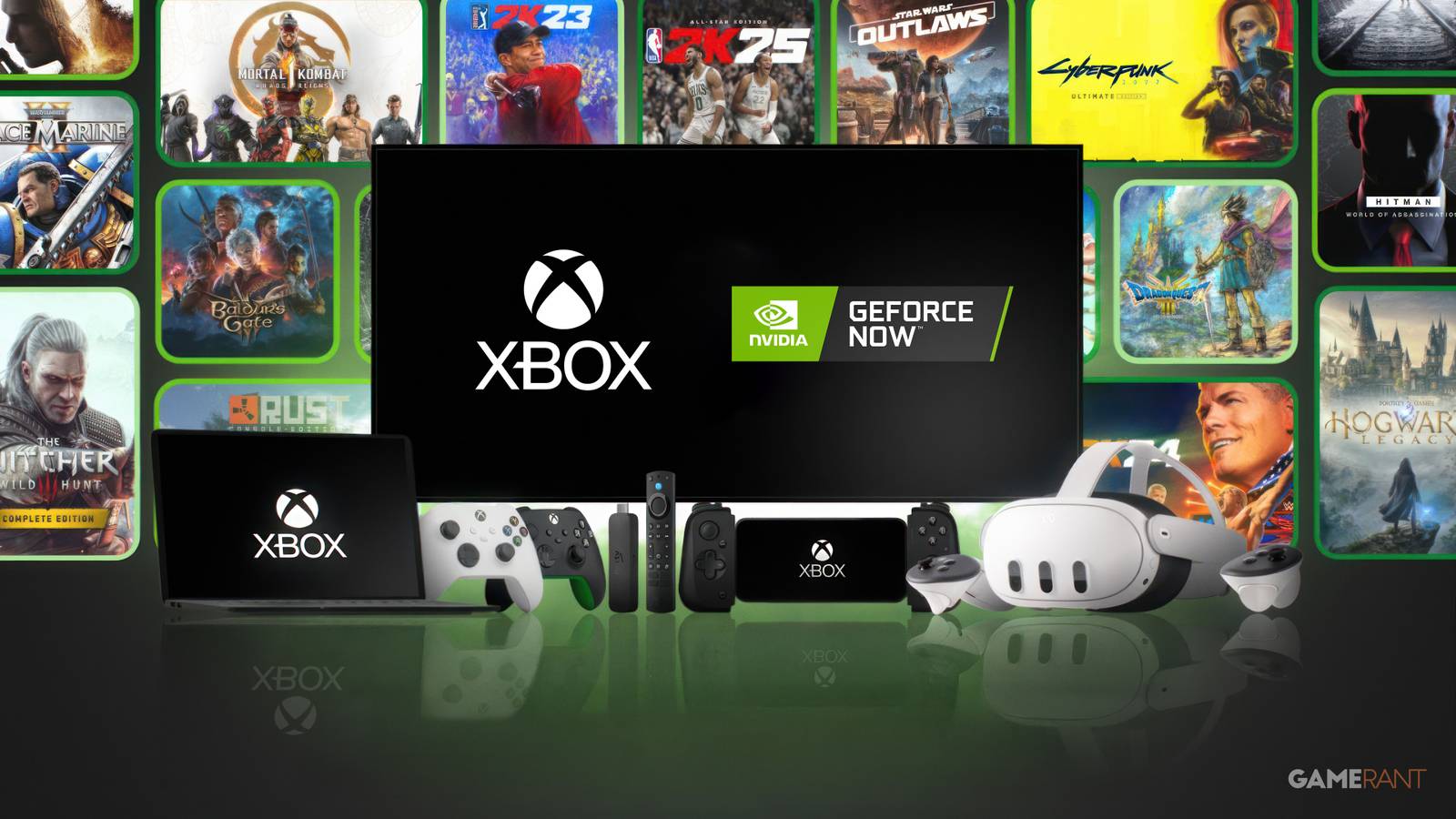Gaming has always been a more impenetrable form of entertainment than most. In a literate society, the overwhelming majority of people can borrow books from a library for free; a Netflix subscription will get you access to thousands of movies and TV shows for as little as $8 a month, and platforms like Spotify make consuming music more affordable and accessible than ever before. By comparison, a modern video game console will set you back several hundred dollars, and the price of individual AAA games continue to swell as well. On top of all this, gaming is a skill that has to be learned—it’s difficult to simply “dabble” in gaming without a substantial investment of time and money.
Cloud-based game streaming platforms like Nvidia GeForce Now and Xbox Cloud Gaming aim to change this, making gaming just as accessible as movies, TV, and music, requiring little more than a stable internet connection and nominal monthly fee. Certainly, streaming video games directly to a computer, console, or mobile device is starting to look like a much more feasible option for many consumers. Even I, a lifelong gamer who owns hundreds of physical and virtual titles, have dipped my toes into Xbox Cloud Gaming a number of times, and have been pleased with the results. But many of these companies, especially Microsoft, have been making the case that cloud gaming is the future of the industry, and could even usurp traditional, local gaming. It’s easy to see the benefits of this paradigm shift, but how realistic is it, really?
Game Streaming Platforms like GeForce Now and Xbox Cloud Gaming Continue to Grow and Improve
Video game streaming, at least conceptually, has existed for longer than many might assume. Ambitious companies were taking swings at the idea as early as 2000, when the startup G-Cluster announced its cloud gaming ambitions at E3. Later, other platforms, notably OnLive and Gaikai, would enter the industry, though they would be short-lived and not widely adopted. But OnLive and Gaikai still wound up being consequential, as they were acquired by Sony and served as the soil from which PlayStation Now would eventually sprout in 2014.
PlayStation Now has only continued to improve, reaching more players each year due to its inclusion in PlayStation Now Premium; it’s also the only way to play several classic games on PS4 and PS5. But while PS Now is positioned as a high-value feature for enthusiast-level PlayStation owners, Xbox is taking a decidedly different approach: Xbox Cloud Gaming, or Xbox Everywhere, as the initiative has been branded, ostensibly aims to surpass local gaming altogether.
We’ve all seen the “This Is an Xbox” ads over the past several months, but Microsoft’s cloud gaming strategy goes back much further than that. According to a report released by Xbox in 2022, more than 10 million people had streamed games through Xbox Cloud Gaming, via an Xbox Game Pass Ultimate subscription. By fall of that year, Xbox said that that number had doubled, and by 2024, Microsoft Gaming CEO Phil Spencer was claiming that Xbox Cloud Gaming accounted for a “double-digit” percentage of total playtime on Xbox platforms—a vague figure, but one that translates to at least several million hours of gameplay.
Xbox Cloud Gaming is backed by Microsoft Azure, a cloud-based computing platform started in 2010.
This aggressive growth is mirrored by GeForce Now. In 2020, Nvidia reported that the streaming service had just over a million registered users; by 2022, it had over 20 million. It should be noted, however, that GeForce Now has a very distinct approach to membership tiers: unlike Xbox Cloud Gaming, there’s a free tier for GeForce Now, though this only allows for up to one hour of uninterrupted play; even higher membership tranches, like the $200/year Ultimate tier, limit both consecutive and monthly streaming hours.
Xbox Cloud Gaming is much more lenient with such limits, but that doesn’t mean that it’s not subject to the same inherent limitations. Indeed, Nvidia’s imposed limits aren’t a trivial matter, but a direct result of the most crucial threats facing cloud gaming as a whole.
Limitations and Hurdles Facing Cloud Gaming
Cloud gaming is a highly speculative market, which should be expected given its rapid, recent growth. It follows that industry leaders like Xbox and Nvidia likely aren’t in great need of additional funding; what they need is more space, and better tech.
Much like fellow hot-topic generative AI, cloud gaming might feel like a nebulous and ethereal technology, but this couldn’t be further from the truth. In reality, cloud gaming platforms require a great deal of hardware to function properly: data centers, already swollen from the cost of cloud save features from gaming companies, have become even more bogged down by the weight of these streaming platforms, and an abundance of servers are required to run these platforms at scale as well. In short, while cloud gaming reduces the hardware burden for consumers, it certainly doesn’t eliminate it entirely. And if a central goal of cloud gaming is to further expand the gaming consumer base, then the hardware burden would, naturally, expand alongside it, ushering in a host of complex logistical, economic, and environmental concerns.
Leaders in cloud gaming are exploring ways to cut down on their initiatives’ resource consumption, with one promising method being GPU resource scheduling. Currently, most games-streaming platforms use a single GPU to run a single game, much like how a standard console or PC would, but a 2017 study from the Institute of Electrical and Electronics Engineers found that new emerging resource management algorithms can better split GPU usage across several applications. In essence, this could mean multiple games running on a single GPU; further developments in this sector could lead to a far more resource-efficient cloud gaming industry. Better for the planet, yes, but also better for these companies’ bottom lines, and hopefully, better for cloud gaming consumers as well.
The more you bore into the subject of cloud gaming, the more you find that it’s far from a simple plan. While it’s marketed as a minimalist and sustainable way to break into the world of video games (your little iPhone can be an Xbox; you don’t need a TV and console, et cetera), this is only true on the individual level. Cloud gaming threatens to have a massive environmental and economic impact, and if the juice isn’t worth the squeeze, then these companies could scale back their endeavors altogether. It’s an industry that intersects with ISP network provisioning, games publishers and their policies, WiFi and 5G availability, and much more—far from a straightforward vision of a gaming utopia.
So, Is Cloud Gaming the Future?
Of course, no one can determine whether cloud gaming will continue to grow exponentially, as much as investors may wish otherwise. Companies like Nvidia and Microsoft present the concept with bright-eyed optimism, but one must remember the distinction between marketing and reality. When Xbox says that over 20 million gamers used Xbox Cloud Gaming in 2022, do they mean to say that these 20 million gamers spent most of their time playing in the cloud? Most likely not. Put another way, just because consumers can, in theory, switch from local gaming to cloud gaming, doesn’t mean they actually will.
One mustn’t forget the tragedy of Google Stadia, an ambitious cloud gaming service launched by one of Earth’s largest technology companies in 2019. One would imagine that if any tech company could sort out the infrastructure and performance woes of cloud gaming, it’d be Google, but that was far from the case: an investigation by the United Kingdom’s Competition and Markets Authority in 2022 estimated that Stadia had only managed to scrape together between 0% and 5% of cloud gaming’s total market share in the two years following its launch, trailing behind PlayStation Now, GeForce Now, and Xbox Cloud Gaming, which held 10-20%, 10-20%, and 60-70% market share, respectively.
Google Stadia shut down in January 2023, lasting just four years.
Naturally, GeForce Now and Xbox Cloud Gaming were doing far better than Stadia at the time that investigation was published, and are presumably doing even better now. But GeForce Now has a free tier, and Xbox Cloud Gaming is a feature offered to those already subscribed to Xbox Game Pass Ultimate, a service that offers hundreds of free games, playable on several platforms, as well as assorted in-game perks, exclusive discounts, and more. Meanwhile, Stadia offered just a few dozen games, with no option to play locally.
Will millions upon millions of gamers (or prospective ones) stick to a subscription that allows them to stream games? How much will they pay for that? Or, in the wake of Microsoft’s infamous $10 Game Pass Ultimate price hike, perhaps a better question would be, how much will these companies actually charge? The streaming business model has followed a familiar trend across mediums: spend a few years Hoovering up subscribers, operating at a loss, before hiking up the recurring cost in an effort to generate a profit. It’s expensive to create and license games, and expensive to run them through mammoth server farms too; will companies like Microsoft and Nvidia raise their prices again, and if they do, will customers be willing to adapt?
For my part, I can still appreciate cloud gaming for what it is. I have Game Pass Ultimate, and will often stream games to my Steam Deck, which is a nice convenience and a great novelty, but it’s safe to say I’m a gaming enthusiast. For cloud gaming to really be the “future” of gaming, it will need to become a viable option for millions of gamers, from the casual to the hardcore. While that’s not impossible, it’s a harder and more uncertain task than the commercials and press releases might have you believe.

- Date Founded
-
April 1, 1993
- Headquarters
-
Santa Clara, California, United States
- CEO
-
Jensen Huang
- Subsidiaries
-
Mellanox Technologies, Cumulus Networks, NVIDIA Advanced Rendering Center
News
Berita
News Flash
Blog
Technology
Sports
Sport
Football
Tips
Finance
Berita Terkini
Berita Terbaru
Berita Kekinian
News
Berita Terkini
Olahraga
Pasang Internet Myrepublic
Jasa Import China
Jasa Import Door to Door
Game online adalah jenis permainan video yang dimainkan melalui jaringan internet. Game ini memungkinkan pemain untuk berinteraksi dengan pemain lain secara real-time, baik itu dalam bentuk kerja sama, kompetisi, atau eksplorasi dunia virtual bersama-sama.







